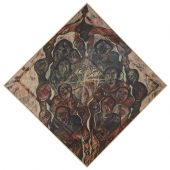Kamala Ibrahim Ishaq
- Country: Sudan
- Exhibitions:
- Parallel Histories
- A Century in Flux
This 1973 composition embodies the haunting figural abstractions of Kamala Ibrahim Ishaq, one of Sudan’s most prominent female artists. Evoking a zaar ritual in which evil spirits are exorcised, often accompanied by ecstatic musical performance. This piece depicts distorted figures whose open mouths appear to call out in anguish. Their faces meld together into abstract organic forms in a monochromatic palette. A prominent figure in Sudan’s art scene, Ishaq was one of a number of artists active during the 1970s, who grappled with questions over artistic knowledge and aesthetic traditions, proposing anti-academic models of production. This work was completed three years before Ishaq, along with four other artists and critics, published the Crystalist Manifesto, outlining their artistic vision, in Al-Ayyam newspaper. The work captures Ishaq’s pictorial language of figurative and abstracted female faces, rhythmically repeated to create a dynamic and meditative composition.
Born in 1939 in Omdurman, Sudan, Ishaq trained at the Faculty of Fine Arts in Khartoum and continued her training at the Royal College in London. She later worked at the College of Fine Art in Khartoum as a lecturer and then head of the painting department. She has exhibited in solo and group exhibitions worldwide, including the groundbreaking exhibition, Forces of Change: Artists of the Arab World at the National Museum of Women in the Arts in Washington, D.C.
تجسد هذه اللوحة، التي تم إبداعها في عام 1973، الأفكار التجريدية التصويرية والمفعمة بالعواطف الجياشة لكمالا إبراهيم إسحق، إحدى أبرز الفنانات السودانيات. وتستحضر اللوحة طقوس "الزار"، أو طرد الأرواح الشريرة، والتي غالباً ما يرافقها أداء مسرحي موسيقي. ويجسد هذا العمل شخوصاً مشوهة تبدو أفواهها الفاغرة وكأنها تصرخ بألم. وتتشابك وجوه هذه الشخوص مع بعضها البعض في أشكال عضوية مجردة ضمن طيف أحادي اللون. وكانت إسحق، وهي شخصية بارزة في المشهد الفني السوداني، واحدة من بين عدة فنانين ناشطين في فترة السبعينيات والذين ناضلوا طويلاً لفهم الكثير من التساؤلات المتعلقة بالمعرفة الفنية والتقاليد الجمالية، ليقترحوا أنماطاً إنتاجية غير أكاديمية. وتم إنجاز عملها هذا قبل 3 أعوام من نشر إسحق، بالتعاون مع 4 فنانين ونقاد آخرين، "البيان الكريستالي" الذي حدد رؤيتهم الفنية في جريدة "الأيام". ويرصد هذا العمل بالشكل الأمثل لغة
إسحق التصويرية للوجوه الأنثوية الرمزية منها والتجريدية؛ فجاءت متكررة الإيقاع لابتكار عمل تركيبي ديناميكي ومفعم بالتأمل. ولدت الفنانة إسحق في أم درمان عام 1939، وتدربت في كلية الفنون الجميلة بالخرطوم، وواصلت تدريبها في الكلية الملكية بلندن. وعملت بعدها في كلية الفنون الجميلة في الخرطوم بصفتها محاضرة ثم شغلت منصب رئيس قسم التصوير. وعرضت إسحق أعمالها الفنية في معارض فردية وجماعية حول العالم، بما فيها المعرض الرائد الذي أقيم تحت عنوان: "قوى التغيير: فنانون من العالم العربي" في "المتحف الوطني للمرأة والفنون" في واشنطن العاصمة.




